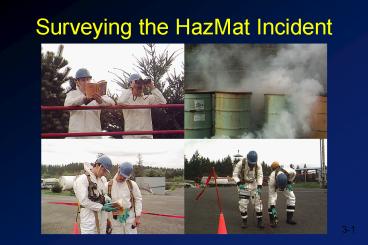Hazardous Materials Operations - PowerPoint PPT Presentation
1 / 41
Title: Hazardous Materials Operations
1
Surveying the HazMat Incident
2
Where are we?
- 1 Introduction
- 2 Awareness Review
- 3 Surveying the HazMat Incident
- 4 Hazard Risk Assessment
- 5 Intro to Incident Command
- 6 Protective Clothing Equipment
- 7 Hazardous Materials Control
- 8 Decontamination
- 9 Termination Procedures
- 10 Safety
- 11 Conclusion
3
General Arrival Considerations
- Initial approach and assessment
- Assess Command location
- Establish zones
- Identify products
- Establish PPE levels
- Establish level of decon
- Conduct risk benefit analysis/rescue
- Make appropriate notifications
4
Initial Approach Assessment
- Upon arrival, approach from upwind uphill, or
to a right angle to the wind direction and/or
gradient
5
Initial Approach Assessment
Approach the scene with caution, as Command may
not have considered all potential aspects
6
Control Scene and Establish Initial Command
Location
- Identify a location for the Command Post and
direct all responding personnel to an appropriate
cold zone area
7
Establish Zones
Establish initial hot, warm, cold zone areas
8
Identify Products
If possible, identify all products involved, and
determine the hazards associated with the incident
9
Establish PPE Levels
- Establish levels of personal protection required
for the hot, warm, cold zones revise the zones
as needed
10
Establish the Level of Decon
Establish the level of decon and the equipment
needed to perform all decontamination tasks
11
Risk Benefit Analysis Rescue
- After conducting a risk benefit analysis, perform
rescue if appropriate
12
Make Notifications
Ensure appropriate agencies and additional
resources are notified
13
Considerations for Good Site Control
- Procedures
- Degree of site control
- When to establish site control
14
Components of Site Mapping
- Site map contents
- Site mapping responsibility
- Site map updates
15
Preparation for Work Activities
- Initiate the steps of Size-up
- Initiate the steps of Strategy
- Initiate the steps of DECIDE
16
Incident Site Work Zones
- Inner perimeter or HOT zone
- Middle perimeter or WARM zone
- Outer perimeter or COLD zone
17
Defensive Operational Guidelines IC Conducts
Information Briefing
- Assigns a Safety Officer (SO) as required in OSHA
regulations - Operations Section Chief reports to IC for all
pertinent information
18
Defensive Operational Guidelines IC Conducts
Information Briefing
The IC and SO identify under what circumstances
the operations will be altered, suspended or
terminated
19
Defensive Operational Guidelines IC Conducts
Information Briefing
The IC and SO identify any safety hazards
requiring correction prior to engaging in
defensive operations
20
Defensive Operational Guidelines Operations
Information Briefing
- The Operations Section Chief then assigns
- a decon officer
- defensive entry personnel
- a back-up team
- a medical officer
21
Defensive Operational Guidelines Discuss
Defensive Concerns
- 1) Does an emergency actually exist?
- 2) If nothing is done, what are the likely
consequences? - 3) What actions have been taken by the initial
arriving first responders prior to this briefing?
22
Defensive Operational Guidelines Discuss
Defensive Concerns
- 4) How have hot, warm, and cold zones been
identified? - 5) Who is to maintain perimeter control?
23
Defensive Operational Guidelines Discuss
Defensive Concerns
- 6) What is the available information on the
product(s) involved? - 7) What are the risks?
24
Defensive Operational Guidelines Discuss
Defensive Concerns
8) What level of response and PPE is needed?
9) Is the appropriate equipment available for the
product(s) involved? 10) Are all personnel aware
of the PPE limitations?
25
Defensive Operational Guidelines Discuss
Defensive Concerns
11) What resources are needed? 12) What are the
defensive operations objectives?
26
Defensive Operational Guidelines Discuss
Defensive Concerns
- 13) Have all defensive entry personnel had input
into the incident mitigation plan?
27
Defensive Operational Guidelines Discuss
Defensive Concerns
- 14) Have all the hazards been evaluated and
re-evaluated?
28
Defensive Operational Guidelines Discuss
Defensive Concerns
- 15) Do all personnel know thoroughly the incident
defensive objectives, strategies, and tactics?
29
Practice the Buddy System 29 CFR
1910.120(q)(3)(v)
- Purpose
- Responsibilities
30
Incident Site Security
- Purpose
- Application
31
Incident Communications
- There should be two types of incident
communications practiced at emergency sites - Internal
- (radio-dependent communications)
- External
- (verbal- sight-dependent communications)
32
Internal Communications
- This type is dependent upon radios, radio
accessories such as bone mikes, throat mikes, etc.
33
Internal Communications
Radios should always be provided for all entry
personnel Workers should be able to communicate
with each other Team Leader or IC
34
Internal Communications
- Used to notify workers of
- estimated low air
- when to curtail work withdraw
- safety updates
- need for crew changes, rest periods, etc.
35
External Communications
- Dependent upon verbal commands, hand signals,
warning devices, signal boards, etc.
36
External Communications
- Provide back-up
- Assist workers
- Free air space
- Provide options
37
Methods Meanings of External Communication
- Personnel must be aware, in advance, of the
methods meanings of external communications,
such as...
38
Methods Meanings of External Communication
- what various signals mean
- what kind of information can best be
transmitted by each method
39
Methods Meanings of External Communication
Effective external communications require an
ability to direct commands to specific worker(s)
40
Additional Communications
- Cellular phones, as an additional resource, can
be provided to
- Incident Command Command Post
- Section Chiefs
- Division/Group Supervisors
41
Safe Work Practices
- Protocols
- SOGs































